Rome's early inhabitants, tribes scattered over the mythical
Seven Hills, drew water directly from the Tiber. They could also probably rely on small pits
or wells for storing rain water, such as the one shown on the right, recently found during an excavation
by the area of Caesar's Forum, which dates back as far as the 6th century BC.
During the Republican age, the Romans exploited the natural springs extant in the inhabited
areas, which kept constantly growing, often building fountains on their sites. Many of their
names, such as Fons Lupercalis, Fons Apollinaris,
Fons Pici, Fons Mercurii, and
others, are recorded by literary sources, and in some cases we also know approximately where
their location was.
|
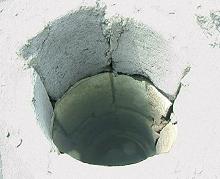
small well (6th century BC) |
Some of them were certainly huge, such as the
Piscina Publica, the
"public pool" in the southern part of the city, which looked more like a reservoir rather than a
typical fountain.
By the early imperial age (1st century
AD) it had already
disappeared, but emperor Octavianus Augustus gave its name to the city's 12th district.
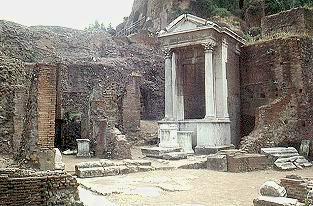
the site of the Lacus Iuturnae
(courtesy of Kalervo Koskimies) |
Today very little is left of the earliest fountains, and the few remains still visible
barely remind us of their original shape. Only the legends they gave birth to have been
handed down in full.
This is the case of the Lacus Iuturnae, named after goddess
Iuturna, patron of workers whose job had a relation with water. The fountain stood in the
Roman Forum's area, by the temple sacred to the Dioscuri (Castor and Pollux, the sons of Jupiter and Leda) because, according to tradition,
in 499 BC, after having fought on Rome's side in a battle, they
stopped here to drink their horses. |
Not much is left of the
Lacus Curtius either, a water
spring or, according to others, a simple basin for collecting rain water, located in the
Forum's area, as well.
The spot where it stands was the last part of a marsh that once
stretched over the whole area where the Forum was built. But according to tradition,
the spring originated when a thunderbolt cracked the ground, in 445 BC,
and consul Gaius Curtius had the area surrounded with a fence. This was
a religious practice: the fall of a thunderbolt was considered to presage negative events,
therefore in such cases a body of ten religious ministers called bidentales presided
the enclosure of the spot, and the burial of a stone as a symbolic representation of the
thunderbolt. The sacrifice of a sheep then followed; on this occasion, the animal was called
a bidental, and the spot too was named after it.
|
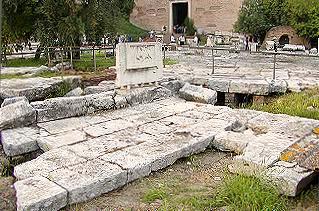
the site of the Lacus Curtius
(courtesy of René Seindal) |
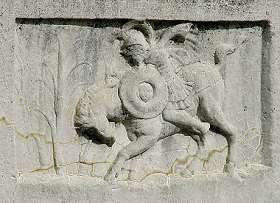
Lacus Curtius: the original relief |
A more adventurous legend tells about the Lacus Curtius as the site of a bottomless hole
which - the oracle foresaw - could have been closed only by throwing
in it what in Rome was most valuable; so in 362 BC the young
cavalier Marcus Curtius, fully armoured and on horseback, threw himself into the hole, which
turned into a harmless spring. The relief that marks the spot illustrates this version of the story.
A third version is about the chief of the Sabines, Metius Curtius,
who fell into the hole.
|
However, the site now appears only as an irregularly paved quadrangle, marked by the replica
of a relief featuring Marcus Curtius on horseback (the original, of Republican age, is kept in the nearby Capitoline Museums).
During the Republican age the number of fountains was still insufficient
for covering the population's needs, especially for those who dwelt off the area of the Forum,
and many romans kept drawing water from the Tiber. For this reason it was not allowed to build houses
within a certain distance from the river's eastern bank (the western side was mainly inhabited
by immigrants and foreign merchants), and the area to be kept free from private properties
was marked with stones, a number of which has been found (see picture on the right).
The real wealth of water began with the making of the many
aqueducts, between the 1st century BC and the 3rd century AD
(see the previous monography), a period during which the number of fountains
in Rome considerably increased; they no longer drew water from nearby natural springs, but from the main
ducts and their numerous secondary branches. |

public area delimitation stone |
One of the most famous ones faced the Colosseum, and was known as
Meta Sudans (literally "the sweating
meta"). It was
shaped as a huge cone, resembling the pillars used in circuses, called
metae, which marked the
ends of the racing track. Its fame was due to the fact that water did not gush out from a
nozzle, but filtered from the inside through the porous stone, giving this fountain
a peculiar glistening ("sweating") look, an absolute novelty in those times.
The Meta Sudans suffered important damages during the Middle Ages, as it already appears
as a ruin in early views of the Colosseum. In 1936, due to its worsened conditions and to
traffic reasons, it was definitively removed, and a round commemorative plaque was set in the
center of the the spot.
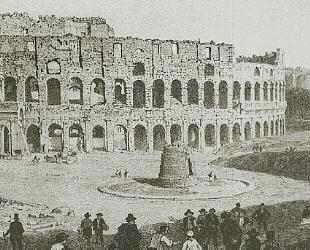
the Meta Sudans in an old engraving
|

photograph taken in the early 1900s: a few years
later these remains would have been removed |
On the opposite side of the Colosseum, the restored remains of a small fountain can be seen
in the area of the Ludus Magnus, the main barracks where the gladiators lived and trained.
Emperor Domitian (AD 81-96) had this complex built close enough
to the large amphiteatre so that it could be reached from the barracks by means of
an underground passage. In the large courtyard of the Ludus Magnus was a small
amphiteatre, for recreating the setting of the Colosseum's arena, and four triangular
fountains in the corners, only one of which is now seen.
|
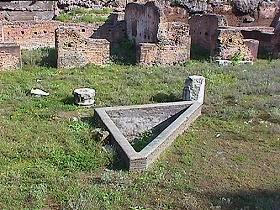 
the small fountain in the Ludus Magnus, also
featured in the Forma Urbis Romae (3rd century map) |
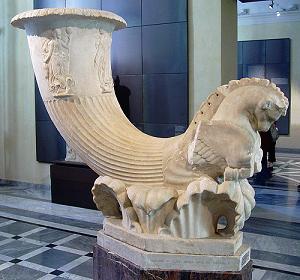
fountain in the shape of a horn,
1st century (Capitoline Museums) |
As the public fountains became more and more numerous, even larger was the number of private ones, although the latter are not the main topic of this monography. They decorated the lavish villas of the high class, and had the most fancy shapes.
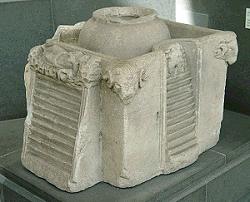
top element from a small fountain
of imperial age (Vatican Museums) |
Roman fountains included the so-called nymphaeums, fountains built with a scenographic setting made of niches, small grottoes or even halls, variously decorated with statues, mosaics, fresco paintings and vegetation. Their size could reach that of major public fountains, or even larger. Most of them stood in private grounds, but a few of them were public.

the remains known as "Mario's Trophies" |
For instance, in the gardens of piazza Vittorio Emanuele are the imposing ruins of the
nymphaeum of Alexander Severus,
now known as "Mario's Trophies". It is also described in the Aqueducts section,
part III - page 1,
as the fountain was the output of a secondary branch given off by three main ducts
that followed the nearby eastern walls of the city. Among its original decorations, none
of which have been left in place, were two marble groups featuring weapons and armour taken from the
barbaric populations fought during the roman campaigns, as a trophy.
|
In the late 16th century these groups were moved to the Capitolium square, where they are still now. Later studies found out that, being earlier than the nymphaeum where they stood, Alexander Severus too had probably taken them from some other pre-existing fountain or building.
The ruins of the fountain are now a shelter for one among Rome's many colonies of stray cats.
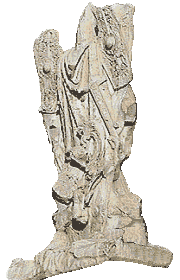
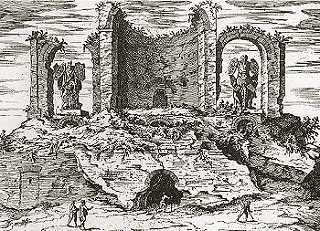
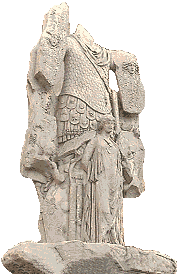
the two groups removed from the nymphaeum of Alexander Severus, and a 16th century engraving featuring them still in place
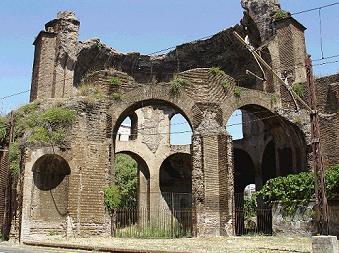
the remains known as 'Temple of Medical Minerva' |
Nearby is the nymphaeum of the Licinii,
built around the 4th century AD.
What are now remains originally formed a round dome-shaped hall, whose walls were very likely covered with paintings
and precious marbles, while in the center one or more statues gushed water, surrounded by flowers and
plants. It stood in the gardens of the Licinii family's villa, which stretched over a
wide area, now crossed by the railway lines. It is still known with its popular name, 'Temple of
Medical Minerva', after a statue of the goddess unearthed nearby, which probably decorated the
aforesaid gardens, and misled the finders about the real purpose of the hall.
|
The nymphaeum is also mentioned in the tour of Aurelian's Walls, part II,
page 3, with other pictures of these impressive though rather neglected remains.
An interesting and complicated story is that of the statue known as
Marforio, a large reclining bearded figure, believed to be
the decoration of an ancient fountain in the Roman Forum.
In 1588 it was moved from its original location to the Capitolium Hill, probably for turning it into a fountain again, but this never happened. A document of the same year states that the statue bore the inscription
MARE IN FORO ("sea in the forum"), whence its corrupted nickname, and the old theory according to which it represents a sea divinity, although experts now believe it refers to a river, likely the Tiber. |
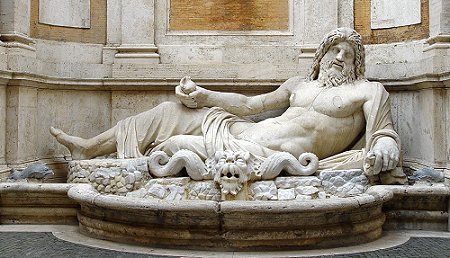
Marforio might have been part of an ancient Roman fountain |
The old interpretation explains why its missing right arm was restored by giving it a new one that holds a sea shell. The statue still stands on the Capitolium Hill, in the courtyard of Palazzo Nuovo, which belongs to the Capitoline Museums.
Marforio used to be rather popular among the roman common people, as it
belonged to the group of so-called 'talking statues',
see
Curious and Unusual -
page 2.
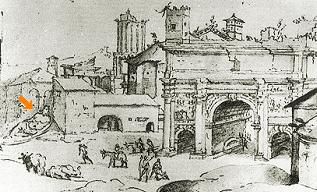
Marforio in its original location (arrow)
in a 16th century drawing of the Forum |
For centuries the statue had lain
unearthed in the nearby Roman Forum area, where some maps and drawings prior to its
repositioning feature it, not far from the arch of Septimius Severus, among other scattered
remains. When pope Sixtus V had it moved to the Capitolium, also its huge round
basin was found. The latter, though, was left in the Forum's area, where it was turned
into a drinking-trough for cattle and horses, and given a new water output in the shape of a
grotesque face carved by Giacomo Della Porta, outstanding fountain-maker
of the late 16th century. |
In 1816 also the basin, up to which rubble and trash had partially grown again, was moved to
a more noble location, below the statues of the Dioscuri in front of the Quirinal Palace,
while the grotesque face was reused for a small fountain by the river bank (the former
will be described in part III, the latter in
part II).
But to be moved, disassembled, rebuilt, and then moved again, is a fate that many
other less ancient fountains too would have shared, later in time.


